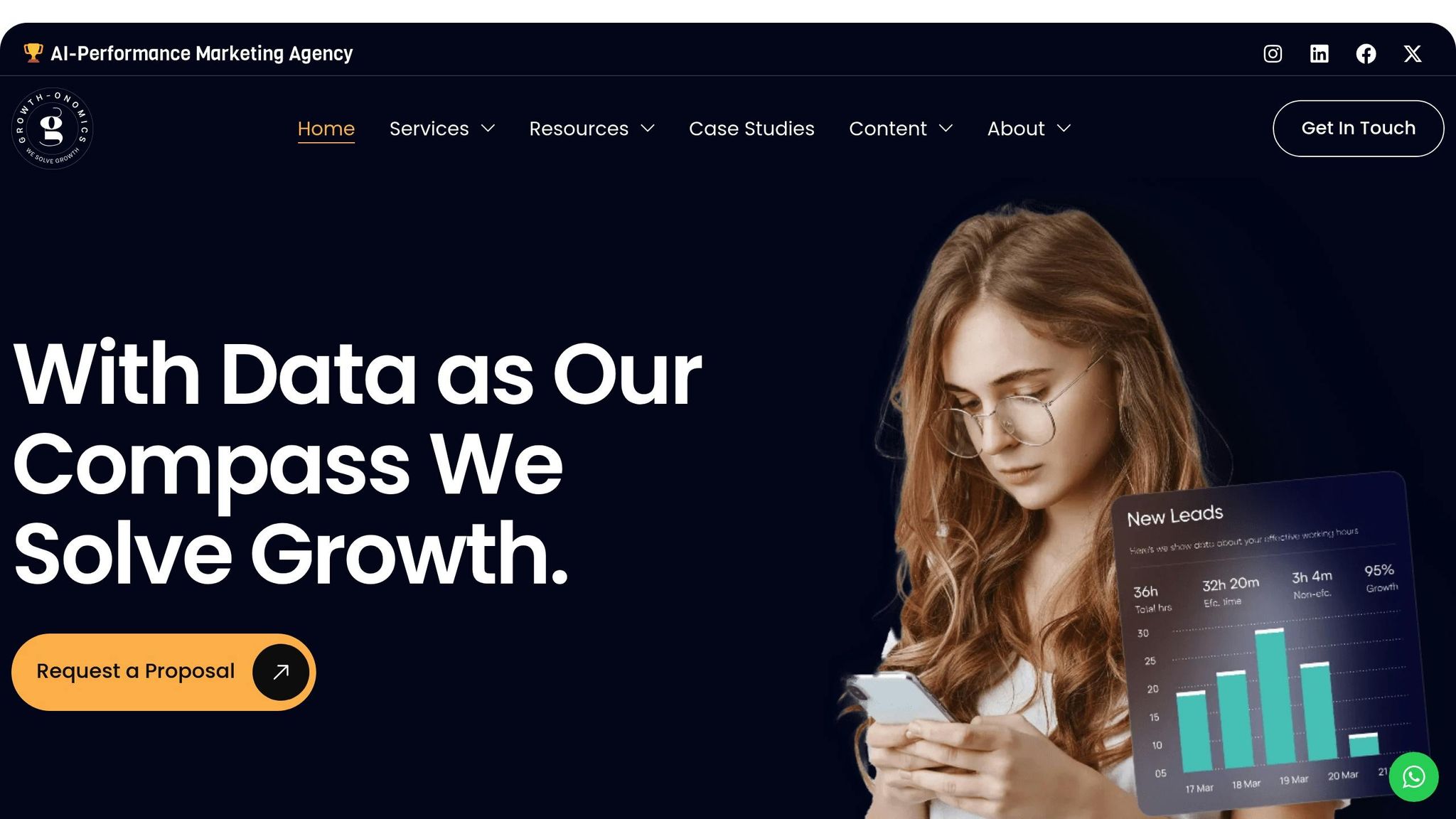Want to predict your conversion rates more accurately? Machine learning can help. It automates and improves predictions, helping businesses understand customer behavior and make smarter marketing decisions. Here’s what you need to know:
- Why It Matters: Predict conversion rates to identify valuable customers, launch campaigns at the right time, and choose effective marketing channels.
- How Machine Learning Helps: Recognizes patterns, provides real-time insights, scales with data, and adapts over time.
- Steps to Get Started:
- Collect clean, reliable data (e.g., user behavior, engagement, demographics, purchase history).
- Transform raw data into features like session duration or average order value.
- Choose the right algorithm (e.g., Random Forest for complex interactions).
- Test and optimize models using metrics like accuracy and F1 score.
- Continuously monitor and retrain models to adapt to new data.
Machine learning isn’t just for big companies. Small businesses can use it to create targeted campaigns, predict customer churn, and grow efficiently through automation. Whether you’re segmenting customers or optimizing prices, these tools can make your marketing smarter and more effective.
Machine Learning in Conversion Optimization: How it Works
Data Preparation Steps
High-quality data is the foundation of accurate conversion predictions. Here’s how to get your dataset ready for success.
Data Collection Methods
To make accurate predictions, you need a well-rounded dataset. Focus on collecting data from multiple channels and tracking key metrics:
| Data Type | Key Metrics to Track | Collection Method |
|---|---|---|
| User Behavior | Page views, scroll depth, time on site | Analytics tracking |
| Engagement | Click-through rates, form submissions | Event tracking |
| Demographics | Age, location, device type | User profiles |
| Purchase History | Order value, frequency, cart abandonment | Transaction logs |
"Sustainable growth stems from more than just data collection." – Miltos George, Partner and Chief Growth Officer
Data Quality Control
Accurate predictions depend on clean, reliable data. Use these steps to ensure your data is ready to go:
-
Data Validation
Automate checks for issues like:- Duplicate entries
- Missing values
- Outliers that could distort results
- Inconsistent formatting
-
Data Standardization
Use consistent formats for dates, currency, geography, and customer IDs. -
Regular Audits
Schedule routine audits to catch and fix data problems before they grow.
Creating Useful Data Features
Raw data needs to be transformed into meaningful features that improve prediction accuracy. Focus on metrics that drive actionable insights:
| Feature Category | Examples | Business Impact |
|---|---|---|
| Time-based | Session duration, time between visits | Pinpoint the best engagement times |
| Behavioral | Navigation patterns, content interaction | Gain a deeper understanding of user intent |
| Financial | Average order value, lifetime value | Forecast revenue opportunities |
| Campaign | Channel attribution, ad response rates | Refine marketing strategies |
A/B testing can help validate the effectiveness of these features, confirming their role in improving conversion rates. With a clean and feature-rich dataset, you’re ready to move on to selecting the right machine learning models.
Machine Learning Model Selection
Selecting the right machine learning model is a key step in achieving accurate predictions. Once your dataset is ready, the next task is to match it with a model that aligns with your goals.
Choosing the Right Algorithm
The algorithm you pick should match the characteristics of your data and the outcomes you aim to predict.
| Algorithm Type | Best Use Case | Advantages | Limitations |
|---|---|---|---|
| Logistic Regression | Simple binary predictions | Quick to train, easy to interpret | Struggles with complex problems |
| Random Forest | Complex feature interactions | Handles non-linear relationships | Requires more computational power |
| Neural Networks | Large-scale pattern recognition | Excellent at detecting patterns | Needs a lot of training data |
| Gradient Boosting | High-precision predictions | Very accurate | Prone to overfitting |
For small to medium-sized businesses, Random Forest often strikes a good balance between accuracy and ease of use.
Evaluating Performance Metrics
When assessing your model, focus on metrics that align with your business objectives:
| Metric | Description | Target Range |
|---|---|---|
| Accuracy | Proportion of correct predictions overall | >85% |
| Precision | Percentage of true positives out of all positive predictions | >80% |
| ROC-AUC | Measures how well the model separates classes | >0.75 |
| F1 Score | Balances precision and recall | >0.80 |
Ensuring Model Accuracy
Thorough testing ensures your model performs well in real-world applications. For instance, in March 2023, Spotify reduced its email bounce rate from 12.3% to 2.1% over 60 days using Mailchimp‘s Email Verification API. This improvement boosted email deliverability by 34% and added $2.3M in revenue.
Key steps for testing include:
- Cross-Validation: Use k-fold validation (5–10 folds) to check model reliability across different data splits.
- Holdout Testing: Set aside 20–30% of your data for final testing to get an unbiased performance estimate.
- Production Monitoring: Continuously track metrics in real-time to spot and address any performance issues.
These processes help ensure your model is reliable and ready for further refinement.
sbb-itb-2ec70df
Model Performance Improvement
After selecting the right model, the next step is to fine-tune and enhance its performance for more accurate predictions.
Parameter Optimization
Adjusting model parameters is key to improving accuracy. Two popular methods for parameter tuning include:
| Optimization Method | Description |
|---|---|
| Grid Search | Systematically tests combinations of parameters to identify the best setup. |
| Bayesian Optimization | Uses probabilistic models to efficiently search for optimal parameters. |
Parameters you might want to adjust include:
- Learning rate: Controls how quickly the model updates during training.
- Tree depth: Important for ensemble methods like decision trees.
- Number of estimators: Determines the number of models in ensemble methods.
- Regularization strength: Helps prevent overfitting by penalizing complex models.
While parameter tuning improves individual models, combining multiple models can take accuracy to another level.
Combining Multiple Models
Ensemble methods combine the strengths of different models to enhance predictions. Here are a few options:
| Ensemble Type | Description |
|---|---|
| Voting Ensemble | Aggregates predictions from multiple models to improve overall accuracy. |
| Stacking | Combines base models with a meta-learner for better predictive performance. |
| Weighted Average | Merges predictions based on each model’s performance, giving stronger models more weight. |
Model Maintenance
Keeping your model up-to-date ensures it performs well as data and user behavior change. Focus on these areas:
-
Automated Performance Monitoring
Set up alerts to flag significant changes in key metrics. -
Regular Retraining
Retrain the model periodically using fresh data to reflect new patterns. -
Data Quality Checks
Continuously monitor for issues like missing values, outliers, or inconsistencies in the input data.
Small Business Implementation
Machine learning (ML) offers small businesses a way to predict conversion rates and improve decision-making.
Custom Marketing Campaigns
With ML, small businesses can design campaigns tailored to customer behavior and preferences.
| Campaign Element | ML-Driven Approach | Expected Impact |
|---|---|---|
| Customer Segmentation | Grouping by behavior patterns | Targeted messaging |
| Message Timing | Predicting optimal times | Increased engagement |
| Offer Optimization | Adjusting prices dynamically | Better conversion rates |
According to Growth-onomics, A/B testing can significantly enhance campaign results. Pair this with predictive analytics to anticipate and address customer churn before it happens.
Customer Retention Strategies
ML isn’t just for marketing – it also helps retain customers by identifying and addressing churn risks.
- Early Warning System: Use automated alerts to flag when customer engagement metrics dip, enabling timely interventions with personalized offers.
- Value-Based Segmentation: Categorize customers by their lifetime value to focus retention efforts on the most impactful segments.
- Behavioral Pattern Analysis: Analyze customer interactions to spot behaviors that often lead to churn, allowing for preemptive action.
"Sustainable growth stems from more than just data collection." – Miltos George, Partner and Chief Growth Officer at Growth-onomics
Automation can amplify these retention efforts, making them even more effective.
Business Growth Through Automation
By combining targeted campaigns and retention strategies with automation, small businesses can drive growth efficiently.
| Focus Areas | Implementation Strategy | Business Impact |
|---|---|---|
| Lead Scoring | Automating prospect qualification | Streamlined sales process |
| Content Delivery | Personalizing content distribution | Higher engagement rates |
| Price Optimization | Adjusting prices in real time | Increased profit margins |
Automation tools should align with your business goals and help conserve resources. Growth-onomics advises starting with essential automation processes and scaling based on performance data.
Conclusion
Summary
Machine learning (ML) has reshaped how businesses predict conversions, offering a data-driven approach that leads to actionable insights and better marketing outcomes. As technology advances, new trends are set to refine these predictive tools, opening up more opportunities for marketers.
Machine Learning Trends
The role of ML in marketing is evolving quickly, with new trends shaping how businesses predict conversion rates. Here are some key developments:
| Trend | Impact | Implementation Focus |
|---|---|---|
| AI-Driven CAC Optimization | Lowers customer acquisition costs | Focused on cost efficiency |
| Predictive Widgets | Improves marketing strategies | Provides real-time ROI insights |
| Real-Time Data Pipelines | Strengthens fraud detection | Enhances risk management |
These trends make ML tools more accessible and effective, especially when paired with thorough testing and optimization strategies.
Growth-onomics Services

Growth-onomics specializes in leveraging these ML advancements to improve conversion forecasting and marketing performance. Their services are designed to deliver precise, data-informed strategies that drive results.
"We transform insights into winning campaigns that drive growth and outperform competitors." – Growth-onomics
Their 5-step approach includes advanced A/B testing, personalized customer journey mapping, detailed performance analytics, and omnichannel marketing optimization. By combining machine learning with traditional marketing expertise, Growth-onomics helps businesses turn predictions into measurable growth, ensuring marketing investments lead to real, impactful outcomes.









